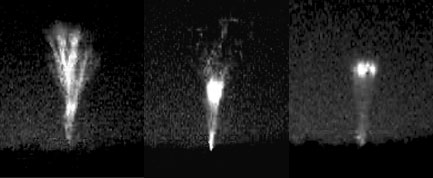Gigantic Lightning Jets Shoot from Clouds to Space

Strokes of lightning flashing down towards the ground are a familiar sight during summer thunderstorms, but scientists have capture an image of a rare lightning bolt shooting out upwards from a cloud, almost to the edge of the Earth's atmosphere.
These bolts of upwards lightning, one type among a variety of electrical discharges now known to occur above thunderstaorms, are called gigantic jets, and were only first discovered in 2001.
Since then, only about 10 gigantic jets have been observed, said Steven Cummer, who was part of the team that photographed this most recent jet. Gigantic jets are essentially the same as cloud-to-ground lightning, only they go the opposite way.
"Gigantic jets are literally lightning that comes out of the thunderclouds, but instead of going down, like most lightning strokes do, these apparently find their way out the tops of thunderclouds, and then keep going and keep going and keep going until they run into something that stops them," Cummer explained.
The something that stops them is the ionosphere, the topmost layer of the Earth's atmosphere (right at the edge of space), which is made up of electrically charged atoms, or ions.
The observations, detailed Sunday in the online issue of the journal Nature Geoscience, confirm that gigantic jets transfer charge from clouds to the highest layers of the Earth's atmosphere, just as their downwards cousins transfer it to the ground.
Lucky observation
Get the world’s most fascinating discoveries delivered straight to your inbox.
Cummer and his colleagues observed the gigantic jet almost by accident. They were set up to observe sprites and other unusual types of above-cloud lightning associated with Tropical Storm Cristobal on July 21, 2008. Instead, they saw the whopper gigantic jet.
"We knew that there was a slim, slim chance that we would see something interesting, like a gigantic jet, but for sure we got lucky to be able to see that. So we were pretty thrilled," Cummer told LiveScience.
Also lucky where the simultaneous radio observations the team was making, which confirmed that gigantic jets are a conduit to move electric charge from the cloud.
"That's what was telling us that at least in this gigantic jet, and probably in most, there actually is a lot of thundercloud charge that has moved from the thundercloud up to the top of the gigantic jet," Cummer said.
Just as with cloud-to-ground lightning, the conduit travels away from the cloud first, and looks fairly faint. When the stroke hits the conducting surface, whether ground or ionosphere, more charge can flow from the cloud and the lightning explodes with light.
Cloud escape
How exactly gigantic jets form and what kinds of storm conditions are necessary to produce them is still unknown.
Electric charge is of course built up in clouds by the motions of water and ice particles. Lightning moves these charges around. But why some lightning goes up and other bolts go down isn't known.
One theory is that high winds at the top of a cloud could nullify a charge layer that would otherwise stop the lightning, thereby allowing it to escape from the top of the cloud. Because nothing else in the atmosphere can stop it until it hits the ionosphere, the lightning can travel about five to 10 times farther than cloud-to-ground lightning, reaching up to about 50 miles (80 km) above Earth's surface.
The thinness of the upper atmosphere also allows gigantic jets to travel much faster than cloud-to-ground lightning.
With every gigantic jet observation made, Cummer and others who study these powerful lightning bolts are hoping to learn more about the conditions that create them and what storms they should be looking for them in.
Researchers in Taiwan have seen gigantic jets sprouting from typhoons (the name for tropical storms in the western Pacific), so these tropical cyclones seem to be good places to look for upwards lightning.
Scientific instruments aren't necessary to see gigantic jets. If you're far away enough from a storm so that your view isn't blocked by clouds, they can be seen ricocheting up through the atmosphere.
"They're definitely bright enough and long-enough lasting to see," Cummer said.

Andrea Thompson is an associate editor at Scientific American, where she covers sustainability, energy and the environment. Prior to that, she was a senior writer covering climate science at Climate Central and a reporter and editor at Live Science, where she primarily covered Earth science and the environment. She holds a graduate degree in science health and environmental reporting from New York University, as well as a bachelor of science and and masters of science in atmospheric chemistry from the Georgia Institute of Technology.


